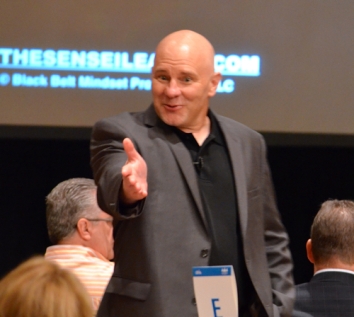“There’s a lack of communication across the organization.”
That’s one of the most common challenges leaders share with me, especially in large organizations or organizations spread across a wide geographic area. However, I hear the same complaint in smaller organizations too where leaders from different departments all park their cars in the same lot.
The problem is usually attributed to headquarters. That is, HQ or top management somehow doesn’t support, encourage or provide opportunities for department or regional leaders to interact, share ideas and best practices and generally support one another.
My stock answer is, “What’s stopping YOU?”
In THE SENSEI LEADER I share this idea:
“The most effective leaders are the people who do without being told, ask before being asked…”
We have literally no barriers to communication today––if we’re willing to communicate. We have free and open access to instant messaging, discussion threads and virtual meeting spaces through online and social media platforms including LinkedIn, Skype and Google Hangouts. For a modest investment, we can access any number of enhanced meeting tools through services like Go To Meeting.
There literally are no excuses––and the fact that top management has not provided you with specific tools or time to talk with your colleagues is certainly not a valid excuse.
Do it yourself!
The only argument I’ve ever heard in response to this suggestion is that HQ discourages or even prohibits this type of informal or unofficial interaction.
Then why are you working for that organization?
Granted, I only work with good organizations. In every company I’ve worked with, if there is a communication break-down it’s not usually intentional, it just devolved into that condition. These organizations welcome input for improvements and are grateful when leaders at all levels take it upon themselves to communicate with one another…
…as long as it’s about doing things better and not just to bitch and moan about HQ!
I also recognize that certain protocols need to be respected. It’s not right to jump over someone’s head or conspire behind someone’s back. Those practices are destructive and well, there’s just plain wrong. It’s also appropriate, useful and frankly, quite easy to include all parties in a discussion instantly––whether that person is an active participant or simply someone who should be in the loop.
Again given our access to communication tools, there is absolutely no reason you can’t make your voice heard when you need to share a concern, problem or idea with someone up the chain of command…
Whether you’re in the same building or in a different country.
Having said all this, there is absolutely nothing that replaces personal, face to face interaction.
Technology allows us to communicate frequently and without restrictions, but it’s also important to provide the opportunity for leaders at all levels of your organization to meet and interact in person, from the front lines to the C-suite. It’s also valuable to get representatives from all levels in the same room at the same time––at least once in a while! Many of the opportunities I have to work with great companies happen at exactly these types of meetings.
If you feel the need to communicate with other leaders in your organization to help you get your job done, to share ideas and innovate, to make your organization stronger––do it! Don’t wait for HQ to give the orders or call the meeting!
At the same time, involve the folks you answer to. Tell them you want more support in encouraging open communication and ask them to work with you to build and maintain protocols and processes that facilitate constructive communication––at all levels.


















 A couple of years ago I was doing a workshop for aspiring entrepreneurs. I asked each of them to give us a quick summary of what kind of business they were starting.
A couple of years ago I was doing a workshop for aspiring entrepreneurs. I asked each of them to give us a quick summary of what kind of business they were starting.



